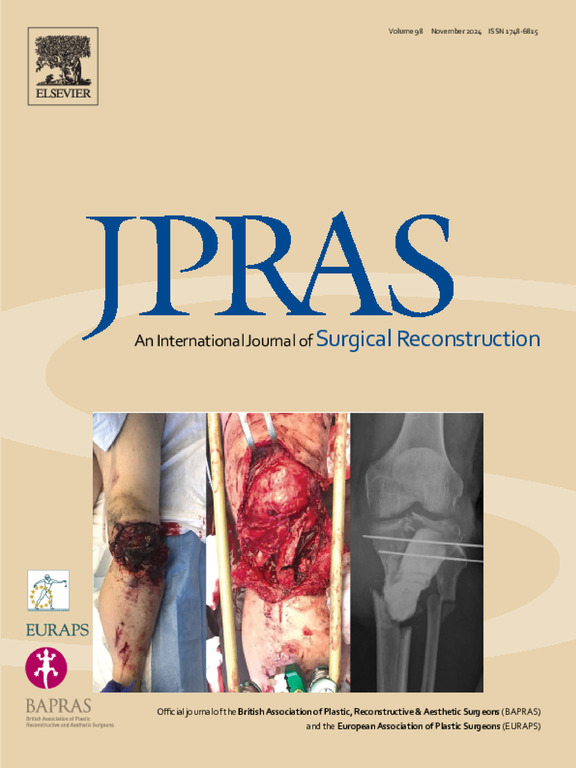What is the current Dutch nerve management during amputation surgery?
IF 2
3区 医学
Q2 SURGERY
Journal of Plastic Reconstructive and Aesthetic Surgery
Pub Date : 2025-06-26
DOI:10.1016/j.bjps.2025.06.015
引用次数: 0
Abstract
Peripheral nerve management during limb amputation is essential, as neuromas frequently form after nerve transection. Some of which are painful and impair patient quality of life. Selecting the appropriate technique for nerve management is important as it may impact the development of painful neuromas. Diagnosis is often complex, and treatments may yield limited success, highlighting the importance of careful nerve handling at the time of surgery. In this study, we questioned Dutch plastic surgeons about their knowledge and preferred technique(s) in managing nerves during amputation surgery. An email survey was distributed among Dutch (plastic) surgeons. The survey was designed in LimeSurvey. The questionnaire addressed background knowledge, preferred nerve management approaches during amputations, and subsequent neuroma treatments. Data were collected anonymously and analyzed using descriptive statistics. Of 390 surgeons, 72 responded (18.5% response rate; 91.7% plastic surgeons). Most respondents (57%) specialized in hand and wrist surgery, with 69% performing 1–10 amputations annually. Surgeons favoring traction neurectomy had less experience (p=0.027). Muscle burying (n=64) was the most familiar technique, followed by bone burying, end-to-side suturing, and targeted muscle reinnervation. Most respondents addressed nerve pain (93%) or considered revision surgery (95%) postoperatively. This study provides an overview of nerve management and neuroma treatment preferences among Dutch (plastic) surgeons. Awareness of various techniques appears widespread, underscoring the importance of training exposure to enhance procedural competence.
目前荷兰在截肢手术中的神经管理是什么?
由于神经瘤经常在神经横断后形成,因此截肢手术期间的周围神经管理是必不可少的。其中一些是痛苦的,并损害患者的生活质量。选择合适的神经治疗技术是很重要的,因为它可能影响疼痛性神经瘤的发展。诊断通常是复杂的,治疗可能产生有限的成功,强调了在手术时小心处理神经的重要性。在这项研究中,我们询问了荷兰整形外科医生在截肢手术中管理神经的知识和首选技术。在荷兰整形外科医生中进行了一项电子邮件调查。该调查是由limessurvey设计的。调查问卷涉及背景知识,截肢时首选的神经管理方法,以及随后的神经瘤治疗。数据匿名收集,并使用描述性统计进行分析。390名外科医生中,72名有应答(有效率18.5%;91.7%整形外科医生)。大多数受访者(57%)专门从事手部和手腕手术,其中69%每年进行1-10次截肢。支持牵引神经切除术的外科医生经验较少(p=0.027)。肌肉掩埋(n=64)是最常见的方法,其次是骨掩埋、端侧缝合和有针对性的肌肉神经重建。大多数受访者在术后解决了神经痛(93%)或考虑翻修手术(95%)。本研究概述了荷兰(整形)外科医生的神经管理和神经瘤治疗偏好。对各种技术的认识似乎很普遍,这强调了培训对提高程序能力的重要性。
本文章由计算机程序翻译,如有差异,请以英文原文为准。
求助全文
约1分钟内获得全文
求助全文
来源期刊
CiteScore
3.10
自引率
11.10%
发文量
578
审稿时长
3.5 months
期刊介绍:
JPRAS An International Journal of Surgical Reconstruction is one of the world''s leading international journals, covering all the reconstructive and aesthetic aspects of plastic surgery.
The journal presents the latest surgical procedures with audit and outcome studies of new and established techniques in plastic surgery including: cleft lip and palate and other heads and neck surgery, hand surgery, lower limb trauma, burns, skin cancer, breast surgery and aesthetic surgery.

 求助内容:
求助内容: 应助结果提醒方式:
应助结果提醒方式:


